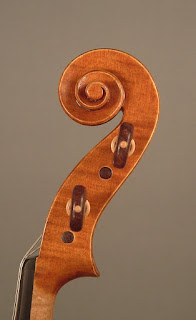I made this C extension for a contemporary bass by Ezio Scarpini.
For this job, I followed the detailed instructions written by William Merchant in the famous book "The Setup and Repair of the Double Bass for Optimum Sound" (Chuck Traeger, with David Brownell and William Merchant, printed by Henry Strobel, Aumsville Oregon 97325 USA, 2004 - ISBN 1-892210-06-1, pp. 360; a recommendable book for all bass repairers and builders). For some aspects of the work, I followed my taste and some constraints imposed by the particular instrument. All parts were made in my workshop. My intern student Satoko Aihara contributed in the initial steps of the making, and helped me gather many hints and examples on Japanese blogs and specialized websites.

A 4-string double bass with a C extension can be used in the orchestra in place of a 5-string bass, and for this purpose a special, longer 4th string is mounted on the instrument. In this instrument, the new upper nut is placed 27 centimeters past the old upper nut (which is cut between the 3rd and 4th) on the extended fingerboard. This will give the low C. The string runs over the nut into the throat of an aluminum 1" wheel (I used a wheel from a sailing hardware store), makes a turn, goes into a hole drilled into the scroll and reaches the A string tuning gear, while the 3rd string is mounted on the E gear. The player can use the "E stop", placed on the side of the original nut, to block the string to the original tuning. The other three keys are used to set the low string to C#, D, D# on convenience. The player can set the most convenient stop during playing and finger the notes on the extended fingerboard by placing the thumb on its underside, which has been made smooth and concave.


The geometry of this neck and scroll dictated some choices in the making. First of all, in this instrument, the line projecting from the fingerboard base almost hits the scroll. This means that, in order to have a normal thickness for the extension at this point, and an easy to finger 4th string, I decided to make the extension out of a single piece of ebony, rather than a separate ebony fingerboard on top of a maple piece. Having a little distance from the fingerboard surface to the pegbox walls, prevented me to install a second wheel to make the 4th string reach the usual (lowest) tuning gear; I chose to follow the common method of bringing the string to the 3rd gear.
The ebony block has been fitted precisely to the pegbox walls and the scroll face, and it is secured in position with two screws. The upper face has been planed and sanded in the right shape so that it is a perfect extension of the fingerboard's shape, and the string doesn't buzz on it when playing with a bow.
For the keys, I tried to design a shape that makes them easy to move into and out of position, without making them looking too slim nor too bulky. At first, I wanted to copy the ones from a Japanese bass extension, which shape reminded me that of a duck's beak. But, it seemed to me that they may be too low for the player's fingers to unlock them easily, so I designed my own shape. They can be reminiscent of the lines of the bow frogs, since they have a curved part towards the string and a concave "cheek" on the opposite part. A small square of leather completes the key's working surface. In order to prevent excessive friction, I have put a small plastic washer between the key and the supporting plate. The brass screw is held by the threaded plate and the serrating force has been set with the aid of a "blind" nut and two drops of thread glue.




The three upper keys are supported by brass plates blocked in position by screws on the flat outer side of the extension. Since there is little wood thickness for the D# extension, I had to change the shape of this plate. This one has a "tongue" extending into a small rectangular cut that I filed into the extension, secured with three small screws, and a supporting base (without screws) that sits onto the pegbox wall and (partially) on the extension side. This prevents the thin brass tongue from bending when the key is closed.
Here are the four keys; all have a 10° skew from the perpendicular axis to the extension surface.
The "E stop" has been mounted on a brass strip, secured to the neck and running on the underside of the original nut, which has been reduced in height, as in the Chuck Traeger's method.
All the keys can be operated with the left hand, without having to hold down the string, and the height of the 4th string with all keys opened, taken at the original nut position, is about 5 mm.
This was quite a complex and demanding job for me, and perhaps the most difficult single job I had to do on a double bass. I am happy that it's working fine!

















































